Figure 2.
Physiological actions of NO in reducing AHF. Endogenous NO is produced by NOS isoforms from L-arginine. Exogenous NO is produced from a class of compounds called NO donors, when administered to biological system. Once produced, NO diffuses into the cytoplasm, interacts and activates the enzyme sGC. Activated sGC hydrolyses GTP to produce cGMP. cGMP activates cGMP-dependent protein kinase (PKG). PKG in turn phosphorylates specific substrate proteins. The substrate proteins may itself constitute the transporter or ion channel, phosphorylation of which causes to affect the physiological function. Phosphorylated substrate proteins may also interact in subsequent steps with the final functional protein to produce the ultimate physiological action. The actions of phosphoproteins are usually terminated by a class of enzymes called phosphatases, which remove the phosphate group from the serine/threonine or tyrosine residues of the substrate protein to bring it back to the resting state.

